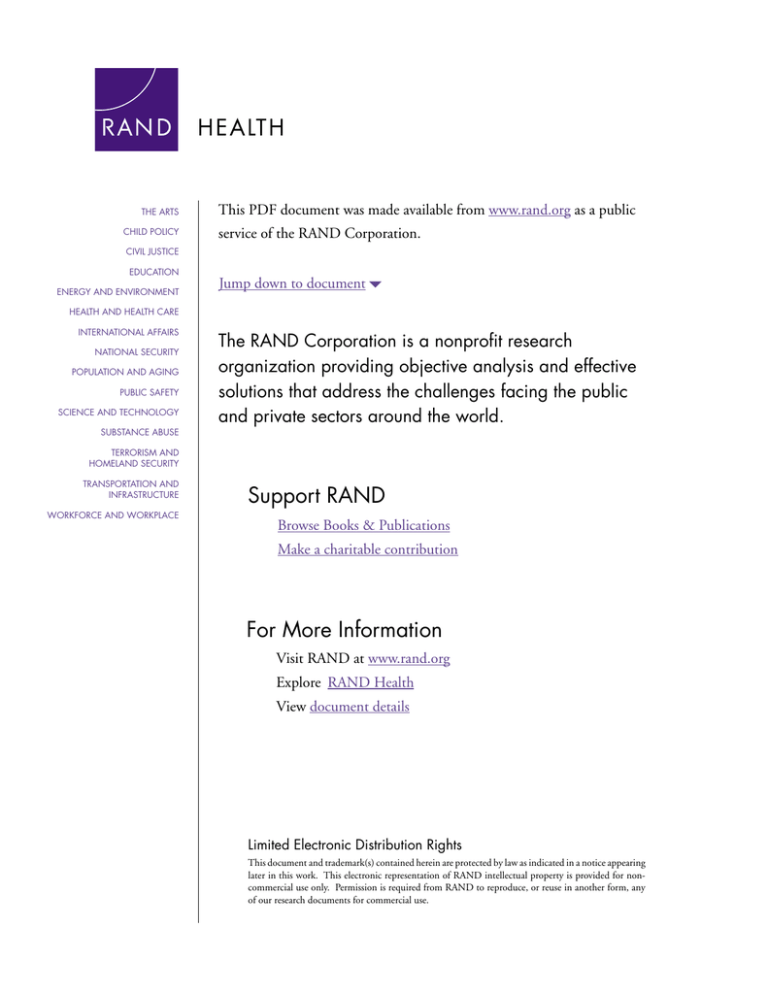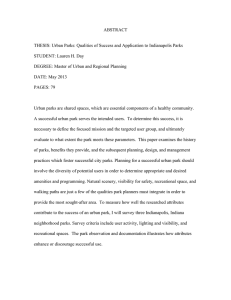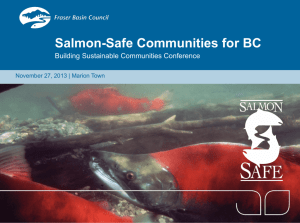
THE ARTS
CHILD POLICY
This PDF document was made available from www.rand.org as a public
service of the RAND Corporation.
CIVIL JUSTICE
EDUCATION
ENERGY AND ENVIRONMENT
Jump down to document6
HEALTH AND HEALTH CARE
INTERNATIONAL AFFAIRS
NATIONAL SECURITY
POPULATION AND AGING
PUBLIC SAFETY
SCIENCE AND TECHNOLOGY
SUBSTANCE ABUSE
The RAND Corporation is a nonprofit research
organization providing objective analysis and effective
solutions that address the challenges facing the public
and private sectors around the world.
TERRORISM AND
HOMELAND SECURITY
TRANSPORTATION AND
INFRASTRUCTURE
WORKFORCE AND WORKPLACE
Support RAND
Browse Books & Publications
Make a charitable contribution
For More Information
Visit RAND at www.rand.org
Explore RAND Health
View document details
Limited Electronic Distribution Rights
This document and trademark(s) contained herein are protected by law as indicated in a notice appearing
later in this work. This electronic representation of RAND intellectual property is provided for noncommercial use only. Permission is required from RAND to reproduce, or reuse in another form, any
of our research documents for commercial use.
This product is part of the RAND Corporation technical report series. Reports may
include research findings on a specific topic that is limited in scope; present discussions of the methodology employed in research; provide literature reviews, survey
instruments, modeling exercises, guidelines for practitioners and research professionals, and supporting documentation; or deliver preliminary findings. All RAND
reports undergo rigorous peer review to ensure that they meet high standards for research quality and objectivity.
Park Use and Physical
Activity in a Sample of
Public Parks in the
City of Los Angeles
Deborah Cohen, Amber Sehgal,
Stephanie Williamson, Roland Sturm,
Thomas L. McKenzie, Rosa Lara, Nicole Lurie
The research in this report was conducted by the Center for Population Health and Health
Disparities, a RAND Health project, and was funded by a grant from the National Institute
of Environmental Health Sciences.
The RAND Corporation is a nonprofit research organization providing objective analysis
and effective solutions that address the challenges facing the public and private sectors
around the world. RAND’s publications do not necessarily reflect the opinions of its
research clients and sponsors.
R® is a registered trademark.
© Copyright 2006 RAND Corporation
All rights reserved. No part of this book may be reproduced in any form by any electronic or
mechanical means (including photocopying, recording, or information storage and retrieval)
without permission in writing from RAND.
Published 2006 by the RAND Corporation
1776 Main Street, P.O. Box 2138, Santa Monica, CA 90407-2138
1200 South Hayes Street, Arlington, VA 22202-5050
201 North Craig Street, Suite 202, Pittsburgh, PA 15213-1516
RAND URL: http://www.rand.org/
To order RAND documents or to obtain additional information, contact
Distribution Services: Telephone: (310) 451-7002;
Fax: (310) 451-6915; Email: order@rand.org
viii
EXECUTIVE SUMMARY
RAND has undertaken this study of public parks in the City of Los Angeles because of
the city’s significant investment in public parks and its commitment to improve them through a
number of funding sources, including Proposition K (Los Angeles for Kids Program), a 30-year,
$25 million-per-year assessment-funded program to revitalize the City's parks and recreation
facilities. This effort is unique in the United States and will provide an unparalleled opportunity
to identify the role that parks can play in facilitating physical activity, population health, and
well-being.
Many health problems can be prevented or alleviated through routine physical activity.
There is a growing consensus that the environment in which we live helps determine how
physically active we are on a daily basis. The goal of our study is to determine how parks
promote physical activity for individuals and how well they serve the surrounding community.
We systematically measured what activities are occurring in public parks, who uses the
park, and what proportion of the local population is actually served by the park. The data come
from surveys of park users, surveys of households within a 2-mile radius from each park, and
systematic observations of all park areas four times a day for all seven days of the week.
The 12 public neighborhood parks studied in this report, as well as a skate park and two
senior citizens centers, represent only a small percentage of all the facilities managed by the City
Of Los Angeles Department of Recreation and Parks. The findings may therefore not be
representative of all parks. Although we found that most residents and park users had a favorable
opinion of the Department of Recreation and Parks services and staff, this study was not intended
to be an evaluation of these services, but an evaluation of physical activity in park settings.
MAIN FINDINGS
Residential proximity to parks is a critical determinant of park use and leisure exercise.
Most park users (81%) live within one mile of the parks, and only 19 percent of park users live
more than one mile from the park. This is a key finding: Proximity to parks matters for physical
activity. That is, even if a large park is only a few miles away from a particular neighborhood,
most neighborhood residents will not use that large park. Most may not have access to even a
small park within a mile radius of their homes (about 3 square miles). Smaller nearby parks
could play a much more important role in the physical activity of neighborhood residents.
ix
Males use parks more than females; children and teens use parks more than adults and
seniors.
Parks do not serve everyone in the community equally, even within local neighborhoods. While
this finding reflects a general difference in physical activity seen nationally between males and
females and between different age groups, parks may contribute to disparities in physical
activity. For this reason, it is important to consider whether facilities available in parks and the
type of programming that is scheduled are attractive to different groups. In Los Angeles,
neighborhood parks have been conceived as active parks, and most have a multitude of facilities
that promote vigorous sports such as basketball and soccer. Baseball is not a particularly
vigorous sport, but it takes up a large portion of park acreage, and is played by a relatively small
number of individuals. Fewer parks have areas for moderate physical activity, such as tracks,
walking paths, and trails. When these features are present, more adults and senior residents tend
to use them.
Most people in the parks are sedentary. For most park users, the most common activity is sitting.
Nevertheless, most have engaged in light or moderate physical activity just to get there, since
most park users walk to the park. Parks with more users are more likely to encourage the
expenditure of more energy and may result in healthier, more active neighborhood residents than
parks with fewer users, even if those users spend most of their time sitting.
People report using parks frequently, yet we observed many areas in the park to be largely
unused during substantial portions of the week.
The majority of neighborhood residents report that they use the parks one or more times per
month. They say that it is easy or even very easy to get to the park. They perceive the parks to be
safe or very safe, and they rate the staff as good to excellent. A large percentage of local
residents report that they participate in programs sponsored by the Department of Recreation and
Parks. Moreover, the majority of residents report that they use their neighborhood parks
exclusively and do not often visit other parks. This again highlights the need for some type of
park in every neighborhood. However, despite the important role that people say parks have
played in their lives, we found during our observations that many areas of parks were empty
throughout the day and sometimes even on weekends. Thus, there is reason to improve the
utilization of existing parks, possibly by scheduling activities that attract people who have time
during the non-peak hours. Nevertheless, overall capacity is unlikely to be sufficient to serve all
residents during peak time.
x
Supervised activities draw more people to the park.
We counted more users in those parks with a greater number of supervised activities. This is
partly because special events like sports competitions attract not just the players but also
spectators. Variation in the number of users across similar types of parks serving similar
populations suggests that changes in programming and events may have a significant impact on
park usage and physical activity.
RECOMMENDATIONS
Optimize proximity to venues for physical activity.
Proximity is important in determining whether or not people will use a park. Many residents are
without a park within a mile of their residence, and there are far more residents than existing
park space can serve. Some creative ideas are needed to develop alternative facilities, such as
walking paths or trails or pocket parks, which would provide additional resources so that
everybody has access to some form of physical activity venue within 1 mile of their residence,
even if it is not a park. Those alternative facilities might also serve a different subgroup of
residents (e.g., adults or senior citizens) better than a traditional park with playing fields.
Creating alternative facilities will require additional space not currently managed by the
Department of Recreation and Parks. Land that might be adapted for recreational use includes
existing city streets, greenways, commercial areas and underutilized lots, including parking lots.
The Department of Recreation and Parks should collaborate with other city departments that are
responsible for land use, sidewalks and streets, and housing and commercial properties to
increase the use of these spaces for physical activity. Parks are desirable walking destinations.
Having additional walking venues closer to residences may help individuals increase their level
of physical activity.
Offer more program services to females and seniors.
More balanced programming services across user types will contribute to increased use of Los
Angeles’ parks. Park leadership might consider offering a greater number of organized activities
that promote moderate physical activity for females, adults, and seniors. Much of park space is
currently devoted to vigorous activities (e.g., basketball), which may be too active for many
people. Both moderate and vigorous activities are needed, particularly for females and
seniors—two groups that currently underutilize park services.
xi
Facilitate walking and moderate to vigorous physical activity.
Moderate activity is important for everyone, and since most people like to walk, making parks an
inviting place for walking should be a high priority for the communities of Los Angeles. Efforts
to improve the design of parks and their facilities should focus on creating more walking paths
and tracks. These could border or surround existing active spaces and/or could be created with
additional features that make them attractive to a broad range of the population. Landscaping that
provides shade for walkers and/or other unique points of interest could draw local residents.
Paths could be added around or outside of existing parks as well, with appropriate signage to
make the route attractive and to help people become aware of distances walked or steps taken.
Parks could organize walking clubs and schedule regular events to encourage community
members to participate. Although most residents say parks are easy to get to, the Department of
Recreation and Parks could work with other city departments to increase the attractiveness and
safety of sidewalks and roads around the parks to encourage more people to walk to them.
Maximize current park capacity.
Parks are underutilized particularly in the mornings and on some weekdays. This provides an
opportunity to develop programming to attract residents who are not at work, including senior
citizens. Senior citizens as a group use parks less often, but when they do use them, they tend to
use those parks offering specific activities and facilities targeted toward seniors (e.g., senior
centers). Also, the addition of more programs for women who may be home in the morning may
be useful to increase their physical activity. Scheduling more supervised activities and events in
the park is likely to draw more park users.




